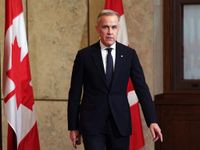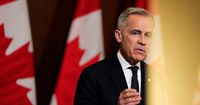OTTAWA — In a bold move that underscores escalating tensions in North American trade relations, Canada has announced a 25 percent retaliatory border levy on all American-made vehicle imports not covered by free trade agreements. Prime Minister Mark Carney made the announcement on April 3, 2025, stating that Canada would largely mirror the new U.S. tariffs on foreign-made autos and components, which took effect at 12:01 am ET on the same day.
Under the new measures, Canada will impose a counter-tariff on American car imports that do not meet the Canada-United States-Mexico Agreement (CUSMA) standards, which require at least 75 percent North American content. According to Carney’s spokesperson, Emily Williams, approximately 10 percent of vehicles imported from the U.S.—around 67,000—were not CUSMA-compliant last year, representing a total value of about $3 billion.
Additionally, Canada will levy a 25 percent tax on all foreign-made components of CUSMA-compliant vehicles exported by the U.S. to Canada. For instance, if a U.S.-made car compliant with CUSMA contains a Japanese-made steering wheel, the tariff will apply to the value of that steering wheel upon importation to Canada. However, unlike the U.S., Carney clarified that Canada would not impose tariffs on U.S.-made vehicle parts crossing into Canada as part of the integrated North American auto supply chain.
Carney estimated that the new border levy could generate around $8 billion annually, which he committed to redistributing to workers and businesses affected by the ongoing trade war with the U.S. He warned that further American tariffs could target sectors such as lumber, agriculture, pharmaceuticals, and semiconductors, emphasizing the need for a comprehensive reworking of trade and security relations between the two nations after the upcoming Canadian federal election on April 28.
“In the year I was born, Canada and the United States signed the auto pact agreement that ended auto tariffs between our nations and began a 60-year period of close cooperation, partnership, job growth, and prosperity,” Carney remarked. “That era has now ended unless the United States and Canada can agree on a new comprehensive approach.”
The announcement was met with support from Quebec Premier François Legault, who argued that dollar-for-dollar counter-tariffs would ultimately harm Canadians more than Americans. The effects of the U.S. auto tariffs were felt almost immediately, with American auto giant Stellantis announcing the temporary layoff of 900 workers in Michigan and Indiana due to slowdowns in Canadian and Mexican plants. Stellantis confirmed that it would also pause production at its Windsor, Ontario assembly plant starting April 7, largely due to the new tariffs.
Ontario Premier Doug Ford expressed concern over the U.S. tariffs, describing them as “clear as mud” and hoping for a temporary resolution to the Stellantis plant closure. Carney noted that Canadians would likely feel the impact of these tariffs before any potential improvements occur, echoing the sentiment that when the U.S. sneezes, Canada catches a cold. “It is usually the case that when the United States has a recession, it’s very difficult for Canada to avoid something similar,” he added.
In the political arena, federal party leaders quickly proposed measures to counter the effects of the new U.S. tariffs. Conservative Leader Pierre Poilievre promised to eliminate the federal sales tax on Canadian-made vehicles and allocate $3 billion for short-term credit lines and low-interest loans to affected workers and businesses. “Axing the GST on a $50,000 Canadian-made automobile will save $2,500 to the car buyer,” Poilievre stated, emphasizing the need to support Canadian families.
Meanwhile, NDP Leader Jagmeet Singh proposed reviving a World War II-era victory bond program to allow Canadians to invest in federal infrastructure projects. Singh argued that investing in domestic infrastructure would alleviate reliance on banks while providing tax-free returns for Canadians. “We’re going to need to raise money to be able to build the roads, the bridges, the infrastructure we need,” he said.
The ramifications of the trade war were starkly illustrated on April 3, as U.S. markets experienced their worst day since 2020. The Nasdaq fell six percent, while the S&P 500 dropped nearly five percent, and the Dow Jones Industrial Average plunged over 1,600 points, or four percent. Analysts warned that if Trump’s tariff strategy is not part of a broader negotiating tactic, it could lead to severe economic repercussions.
Trump, for his part, remained optimistic about the situation, asserting that the trade war was progressing well. He likened the U.S. economy to a patient undergoing surgery to address a chronic balance-of-payments deficit caused by excessive imports. “The operation’s over. And now we let it settle in,” he said, suggesting that healing would soon begin.
As the political landscape evolves, the Canadian government faces the challenge of navigating these turbulent trade waters while ensuring the protection and prosperity of its citizens. With the federal election looming and the stakes higher than ever, Carney’s administration is tasked with finding a path forward that mitigates the adverse effects of the trade war and strengthens Canada’s position in the global economy.
In summary, Canada’s decision to impose retaliatory tariffs on U.S. vehicles marks a significant escalation in the ongoing trade conflict. As both nations grapple with the consequences of their respective policies, the outcome of the upcoming Canadian federal election will play a crucial role in shaping the future of trade relations between the U.S. and Canada.







